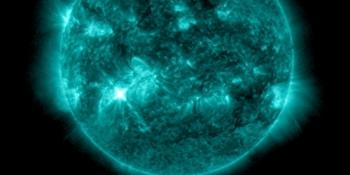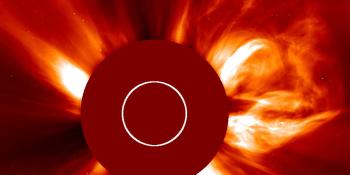Przeglądasz Archiwum z czwartek, 19 czerwca 2003
Raport geofizyczny
Każdy wspomniany rozbłysk słoneczny w tym raporcie ma współczynnik skalowania dodany przez Space Weather Prediction Center (SWPC). Przez skale współczynników SWPC, raporty o rozbłyskach słonecznych są o 42% mniejsze niż naukowo jakościowa data. Skale współczynników zostały usunięte z naszych archiwów o rozbłyskach słonecznych by odzwierciedlić prawdziwe jednostki fizyczne.
Podsumowanie aktywności słonecznej i geofizycznej 2003 Jun 19 0245 UTCPrzygotowane przez NOAA © SWPC i przetworzone przez SpaceWeatherLive.com
Połączone podsumowania aktywności słonecznej i geofizycznej z USAF/NOAA
Numer SGAS 170 zaznaczony w 0245Z na 19 Jun 2003 Ten raport został stworzony na podstawie danych pochodzących z SWO na 18 JunA. Zdarzenia energetyczne
Zacznij Maks Koniec Region Lokacja Promienie X Operacja 245MHz 10cm Przej 2227 2255 2312 0386 M6.8 1200 2100 II/IV
B. Zdarzenia protonowe
The greater than 10 Mev proton fluxes at
geosynchronous orbit reached event threshold at 18/2050Z and due to
the recent activity the exact source for this particle event is not
certain at this time but is most likely from the M6.8 x-ray flare
from 17 June..
C. Podsumowanie aktywności geomagnetycznej
The geomagnetic field was at
predominantly minor to major storm levels with an isolated period of
severe storm conditions seen at high latitudes between 18/0600 and
0900Z. A co-rotating integrated region preceding a recurrent high
speed coronal hole stream and is believed to responsible for the
storm conditions.
D. Ostrzeżenie stratosferyczne
Żaden
E. Dzienne wskazania (wstępne/ szacowane wartości aktualizowane w czasie rzeczywistym)
10 cm 120 SSN 099 Afr/Ap 045/054 X-ray Background B3.2 Dzienny przepływ protonów (całkowity przepływ przez 24h) GT 1 MeV 2.5e+07 GT 10 MeV 1.4e+06 p/(cm2-ster-day) (Satelita GOES-8 na orbicie synchronicznej W128 stopni) Dzienny przepływ elektronów GT 2 MeV 2.30e+06 e/(cm2-ster-day) (Satelita GOES-12 na orbicie synchronicznej W75 stopni) 3-godzinne wskazania indeksu K Boulder 5 5 6 6 3 5 4 3 Planetary 5 6 7 6 4 4 4 4
F. Komentarze
Żaden PLAIN K-Indices: On 16 June, it was determined that a scaling problem exists with the Boulder magnetometer instrument. While this problem, and its fix are being investigated the primary instrument for Boulder K-indices has been switched to the Boulder USGS (via Domsat) magnetometer, effective 1500 UTC on 16 June. GOES Protons: To ensure continued operational monitoring of important energetic particle data, it is necessary to reassign primary/secondary designations for the GOES Space Environment Monitor (SEM) detectors. GOES 11 (113W) will become the primary satellite for protons. The transition from GOES 8 to GOES 11 was scheduled for 18 June, but has been delayed until 19 June. GOES 12 will continue as the primary satellite for magnetometer, X-ray, and electron measurements. GOES 10 (135W) will be the secondary satellite for all SEM sensors - magnetometer, X-ray, and energetic particles. Because of the degraded state of the proton data on GOES-10, its designation as the secondary source for proton data is a short-term solution. More permanent solutions have been identified and are being evaluated. Users will be notified when we define and schedule a permanent fix. Further details can be found at http://www.sec.noaa.gov/GOES.html. 99999
Wszystkie czasy w UTC
<< Idź do codziennego przeglądu
Najnowsze wiadomości
Najnowsze wiadomości z forum
Więcej tematówWesprzyj SpaceWeatherLive.com!
Wielu ludzi odwiedza SpaceWeatherLive aby śledzić aktywność słoneczną lub sprawdzić czy jest szansa na zaobserwowanie zorzy polarnej. Niestety, większy ruch na stronie oznacza większe koszty utrzymania serwera. Dlatego, jeśli jesteś zadowolony ze strony SpaceWeatherLive, zachęcamy do wspierania nas finansowo. Dzięki temu będziemy mogli utrzymać naszą stronę.

Fakty na temat pogody kosmicznej
| Ostatnie rozbłyski klasy X | 2024/12/08 | X2.2 |
| Ostatnie rozbłyski klasy M | 2024/12/26 | M7.3 |
| Ostatnia burza geomagnetyczna | 2024/12/17 | Kp5+ (G1) |
| Dni bez plam słonecznych | |
|---|---|
| Ostatni dzień bez skazy | 2022/06/08 |
| Średnia miesięczna liczba plam słonecznych | |
|---|---|
| listopada 2024 | 152.5 -13.9 |
| grudnia 2024 | 119.3 -33.2 |
| Ostatnie 30 dni | 122 -35.7 |


